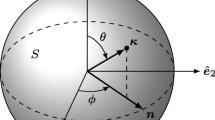A general Love solution for the inhomogeneous linear transversely isotropic theory of elasticity with the elastic constants dependent on the coordinate r is proposed. The axisymmetric case is analyzed and cylindrical coordinates are used. The key steps of deriving the classical Love solution are described for further use of the derivation procedure. The procedure of generalizing the Love solutions to the inhomogeneous theory of elasticity is detailed. This is the fifth publication in the series on general solutions in the inhomogeneous theory of elasticity. The new results obtained are promising for the modern theory of functionally graded materials
Similar content being viewed by others
References
M. Yu. Kashtalyan and J. J. Rushchitsky, “General Hoyle–Youngdahl and Love solutions in the linear inhomogeneous theory of elasticity,” Int. Appl. Mech., 46, No. 1, 1–17 (2010).
M. Yu. Kashtalyan and J. J. Rushchitsky, “Love solutions in the linear inhomogeneous transversely isotropic theory of elasticity,” Int. Appl. Mech., 46, No. 2, 121–129 (2010).
M. Yu. Kashtalyan and J. J. Rushchitsky, “General Love solution in the linear isotropic inhomogeneous theory of radius-dependent elasticity,” Int. Appl. Mech., 46, No. 3, 245–254 (2010).
V. A. Lomakin, Theory of Elasticity of Inhomogeneous Bodies [in Russian], Izd. Mosk. Univ., Moscow (1976).
H. Ding, W. Chen, and L. Zhang, Elasticity of Transversely Isotropic Materials, Springer, Dordrecht (2006).
A. N. Guz and J. J. Rushchitsky, “Nanomaterials: On the mechanics of nanomaterials,” Int. Appl. Mech., 39, No. 11, 1271–1293 (2003).
A. N. Guz, J. J. Rushchitsky, and I. A. Guz, “Establishing fundamentals of the mechanics of nanocomposites,” Int. Appl. Mech., 43, No. 3, 247–271 (2007).
Guz A. N., J. J. Rushchitsky, and I. A. Guz, “Comparative computer modeling of carbon-polymer composites with carbon or graphite microfibers or carbon nanotubes,” Comput. Model. Eng. Sci., 26, No. 3, 159–176 (2008).
I. A. Guz and J. J. Rushchitsky, “Comparing the evolution characteristics of waves in nonlinearly elastic micro- and nanocomposites with carbon fillers,” Int. Appl. Mech., 40, No. 7, 785–793 (2004).
I. A. Guz and J. J. Rushchitsky, “Theoretical description of a delamination mechanism in fibrous micro- and nano-composites,” Int. Appl. Mech., 40, No. 10, 1129–1136 (2004).
I. A. Guz, A. A. Rodger, A. N. Guz, and J. J. Rushchitsky, “Developing the mechanical models for nanomaterials,” Composites. Part A: Applied Science and Manufacturing, 38, No. 4, 1234–1250 (2007).
I. A. Guz and J. J. Rushchitsky, “Computational simulation of harmonic wave propagation in fibrous micro- and nanocomposites,” Compos. Sci. Technol., 67, No. 4, 861–866 (2007).
I. A. Guz, A. A. Rodger, A. N. Guz, and J. J. Rushchitsky, “Predicting the properties of micro and nano-composites: from the microwhiskers to bristled nano-centipedes,” Philos. Trans. Royal Society A: Ìathematical, Physical and Engineering Sciences, 365, No. 1860, 3233–3239 (2008).
M. Kashtalyan, “Three-dimensional elasticity solution for bending of functionally graded rectangular plates,” Europ. J. Mech. A/Solids, 23, No. 5, 853–864 (2004).
M. Kashtalyan and M. Menshykova, “Three-dimensional elastic deformation of a functionally graded coating/substrate system,” Int. J. Solids Struct., 44, No. 16, 5272–5288 (2007).
M. Kashtalyan and M. Menshykova, “Three-dimensional analysis of a functionally graded coating/substrate system of finite thickness,” Phil. Trans. Royal Society A, 336, No. 1871, 1821–1826 (2008).
M. Kashtalyan and M. Menshykova, “Three-dimensional elasticity solution for sandwich panels with a functionally graded core,” Compos. Struct., 87, No. 1, 36–43 (2009).
M. Kashtalyan and M. Menshykova, “Effect of a functionally graded interlayer on three-dimensional elastic deformation of coated plates subjected to transverse loading,” Compos. Struct., 89, No. 2, 167–176 (2009).
M. Kashtalyan, M. Menshykova, and I. A. Guz, “Use of a functionally graded interlayer to improve bonding in coated plates,” J. Adhesion Sci. Technol., 23, No. 11–12, 1591–1601 (2009).
M. Kashtalyan and J. J. Rushchitsky, “Revisiting displacement functions in three-dimensional elasticity of inhomogeneous media,” Int. J. Solids Struct., 46, No. 19, 3654–3662 (2009).
A. E. H. Love, A Treatise on the Mathematical Theory of Elasticity, Dover, New York (1944).
V. P. Plevako, “On the theory of elasticity of inhomogeneous media,” J. Appl. Math. Mech., 35, No. 5, 806–813 (1971).
Author information
Authors and Affiliations
Corresponding author
Additional information
Translated from Prikladnaya Mekhanika, Vol. 46, No. 4, pp. 3–13, April 2010.
Rights and permissions
About this article
Cite this article
Kashtalyan, M.Y., Rushchitsky, J.J. General love solution in the linear inhomogeneous transversely isotropic theory of radius-dependent elasticity. Int Appl Mech 46, 367–376 (2010). https://doi.org/10.1007/s10778-010-0318-0
Received:
Published:
Issue Date:
DOI: https://doi.org/10.1007/s10778-010-0318-0



